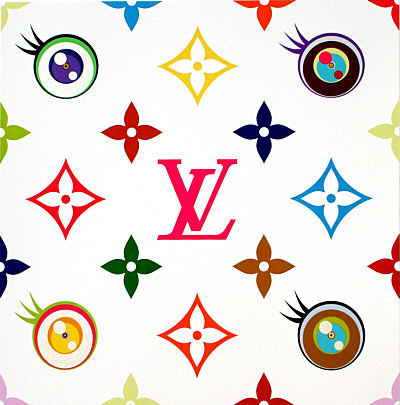Nothing I say about this guy, Takashi Murakami, will really do him justice, so perhaps a bit of bits of info rather: this guy developed the concept of Superflat: taking what is referred to as high art (i.e. shit that sells for unnecessary amounts of money) and juxtaposing/converting/normalizing it with low art (i.e. heavily commercialized symbols like brand logos). In his case, this mostly is with regard to Japanese culture but then you get things like this

where he combines manga and the LVMH brand. Back in ~2004, when this design was exhibited, your favourite handbag mfgr Louis Vuitton was on site selling these things in the museum for $10k. Not too far away, a knockoff peddler in a parking lot was selling a similar tchotchky for $10 (Murakashi-sponsored though).
He's compared to Andy Warhol and Jeff Koons over and over again with the concept of pop art, but in this case he takes it further in terms of blurring lines as it seems his entire goal is to equalize the expensive and the cheap. Now, I'm only referring to the concept and design of the two. The actual reason why there is a difference, physically, is the handiwork into it. Conceptual normalization is still conceptual. For example, he's got a company named Kaikai Kiki which sells his designs en masse. Some of these are get sold at the thousand-dollar marks but they also put out $3.50 Cracker Jack-style trinkets that get sold at 7-11's. The higher-dollar (and therefore higher art obviously) are actually recreations of Takashi's designs done by art interns etc. A la footnote from ©Murakashi p.129:
Generally speaking, each painting is based on a handmade sketch by Murakami, which is then developed into a schematic digital rendering with the help of tehcnical assistants in his Japanese studio... The paintings are then executed... by highly trained studio assistants, who deviate as little as possible from the original concept rendering. Finally, Murakami inspects each painting to make sure that it meets his artistic standards (however ineffably defined), and substandard works are corrected or repainted entirely... Here it should be noted that the rejection or correction of indivitdual works has come to play an important part in the mythology of Murakami's practice: Whether or not an outsider would be able to grasp a work's deficiencies, the pretense of final quality control functions as a kind of guarantee of the painting's "authenticity" as an expression of the master's vision...
This practice mimics the standards advertised by the makers of high-end luxury goods who often boast of rejecting raw materials or finished products that are insufficient in quality to bear the brand's name.
Here are some more examples of his work:

Inochi Which reminds me of the video for Silent Shout.

Milk Natural public reaction to this one.

I open wide my eyes but I see no scenery. I fix my gaze upon my heart.
Reminds of the Young/Old woman optical illusion.
Again, thanks Larry for getting me this book.
P.S. Geez, how long does it take to publish a post around here? This one's been on the backburner for 2 months now.



1 comment:
I've heard of this guy... he is really cool.
Post a Comment